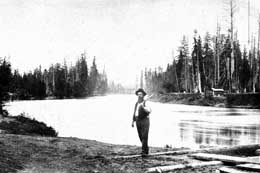In September 1863, lumberman Eugene D. Smith and his partner Otis Wilson arrive on the Snohomish River to set up the first logging operation on the river. Experienced at logging with oxen, Smith settles with two squatters for the site and begins to clear the land for a home and a camp. After buying out Wilson, he goes on to build a store, wharf, hotel, blacksmith shop, the post office, and the first sawmill in the area. He names his settlement Lowell after Lowell, Massachusetts. A huge paper mill will follow. For many years, E. D. Smith and logging at Lowell will be the largest economic force on the Port Gardner Peninsula (site of the future city of Everett).
Pioneer Lumberman
Twenty-five-year-old Maine native Eugene D. Smith (1837-1909) arrived with his partner Otis Wilson in September 1863 to set up a logging operation on the Snohomish River. The year before they had logged at Brown’s Bay, just north of present-day Edmonds. That was the first operation in the area employing oxen on the “Snohomish coast” (History of Skagit and Snohomish Counties). The camp included 10 oxen and 15 men. Now at an angled bend where the water was deep and an undercurrent strong enough to hold logs, Smith found the perfect spot to establish the first logging camp on the river. After buying out squatters Frederick Dunbar and Burlingham Brown, Smith began to log.
The area around the camp was a “incredibly dense mat of timber and underbrush running all the way from the peak of the ridge to the riverbank” (Story of Lowell). Farther up the hill from the river stood ancient Coast Salish burial platforms at a place called Chi-cha-dee-ah. Smith cleared several acres around the necropolis and built his first home, where he lived for 25 years.
In 1865 Smith bought out his partner. He continued to log. Eventually he ran three separate camps employing more than 150 men. One of the camps located a mile up the hill from his home was large enough to be considered a small village. It contained a large number of log huts and a good-sized boarding house. The logging site was another mile to the west.
Lowell Comes into Its Own
After marrying his childhood sweetheart, Margaret Getsell, in 1869, Smith turned his efforts toward making his settlement on the river into something more substantial. Outside of logging camp buildings, there was only a bordello run by Rueben Lowe. Smith and his wife decided to open a general merchandise store. A wharf followed not long after. Soon the little settlement had a school with six pupils. They met in a vacant building donated by Smith.
In 1871 the area’s first post office was establish. Smith was appointed postmaster, a post he would hold for 21 years. For the first time the name “Lowell” showed up on the map, a suggestion of Rueben Lowe who was born in Lowell, Massachusetts. In May 1873 Smith platted the hilly town into 33 blocks with 60 by 120 foot lots, all clear cut with stumps. The Smiths were the sole proprietors. In an expansive mood, they built a two-story frame building at the back of their store and called it the Lowell Hotel. A blacksmith shop went up next.
For the next decade, Smith continued to log. He improved, cleared, and ditched 75 acres into cultivation while holding onto another 5,000 acres of timber, stump and farmland. All but 1,600 acres were on the Port Gardner Peninsula, the site of the future city of Everett. Then in 1889, he began to build again. He spent $60,000 to build a sawmill at Lowell, added a new wing on his store, built a large warehouse, a new wharf, established a waterworks, and a very costly hotel named the Great Northern. By the end of 1890, Lowell had expanded. E. D. Smith retired from the logging business. Always the “Father of Lowell,” in a last move, he arranged with big East Coast investors to locate a paper mill at Lowell just as Everett was forming.
The Paper Mill
“Army of Men at Work on A Mammoth Establishment,” the Port Gardner News reported on Sept 11, 1891. “Best plant Ever Built. 12,000 cords of wood to be converted into pulp annually.” By November The Snohomish Eye remarked that the town of Lowell, which had once been hardly more than a landing place, was now “improved much during the past year. Several new business houses and quite a number of fine residences have been erected. The paper mill is expected to be the largest in the United States. When completed it will cover several acres ... The fine appearing three-story Paper Mill Hotel is a credit to the town.” The Puget Sound Paper Mill would prove to be an important employer and one of the few industrial businesses to survive the difficult 1890s that were to come. Lowell held on and grew, well into the mid-twentieth century.
Like many places of the time, Lowell came into being through the vision and trial-and-error efforts of a singular person, E. D. Smith. Today, Lowell is a residential area. In the 1960s, it was incorporated into Everett. A riverfront park along the Snohomish River marks where Lowell once stood.

